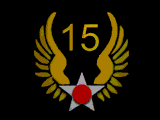|
|
2nd Lt. Dana V. Varvil
720th Squadron
Of the 3,781 airmen shot down during the U.S. Army Air Corps raids on Ploiesti during World War II, only 1,185 survived. Dana Varvil of Powell Township is one of those who lived to tell the tale.
Varvil, 91, was born Dec. 22, 1915 in Essingham, Ill. Shortly after his birth, Varvil’s family moved to Kingsford. Varvil left school to help support the family during the Depression.
He worked, among other jobs, on Loma Farms near Big Bay.
Varvil joined the Army in April 1941, several months before the United States was attacked by the Japanese at Pearl Harbor, launching the country into World War II.
He served 18 months in the Army until he became an Army Air Corps cadet.
It didn’t take Varvil long to be promoted to first lieutenant and pilot, and assigned a crew.
Varvil and his crew successfully bombed the Romanian oil refiners at Ploiesti in their B-24 Liberator the “Destiny Deb,” on April 5, 1944.
On April 23the plane’s crew got the name “Varvil’s Lucky Crew,” and with good reason.
Coming in from a long mission in Germany, the crew ran out of gas a few minutes before their turn to land.
With only minutes between life and death, Varvil crowded into the landing approach of another flight with one engine gone. Just short of the runway another engine died out.
Varvil put full power onto his last two remaining engines and made it down the runway. Not even a hundred feet down the runway, a third engine died out.
With the last remaining engine, Varvil put the plane in the mud to clear the runway.
On April 24, the B-24 bomber “Destiny Deb” took off to once again bomb the Ploiesti refineries, but the plane’s destiny would soon be written.
The refineries in Ploiesti, according to Varvil, produced somewhere around 70 percent of the German oil resources.
“Ploiesti had the most concentrated flak for a small area. For its size, it was comparable to Berlin,” said Varvil. “We didn’t have a fighter escort neither.
Our escorts hadn’t reached Italy yet.”
After dropping its load and heading back, the Destiny Deb took a direct hit from flak and started to go down.
“It was the most helpless and loneliest feeling I ever had — watching our group getting smaller in the distance as they headed home,” said Varvil.
After struggling to get the plane aligned; Varvil parachuted out and watched during his descent as plane turned in a half mile circle and lost altitude at the same rate as he was.
The plane completed its turn with Varvil dead ahead.
“I thought, ‘Oh God, after all this and getting out of it — I’m going to get killed by my own ship,’” said Varvil.
With the ship about 200 or 300 yards away, an unbelievable stroke of luck happened.
“The number three engine blew up,” said Varvil.
With the loss of power, the Liberator turned away from Varvil and crashed into the ground.
Varvil and his crew were captured by peasants and turned over to Romanians, then the Germans. Amazingly all 10 crew members survived.
The average survival rate for a crew forced to bail out was three out of 10
His crew also carried two interesting items with them while they were POW’s.
“I was talking to a man who just got liberated and I asked him if he wished he had anything when he was a POW,” said Varvil. “He told me he wished he had a toothbrush and razor.
From then on we carried a toothbrush and razor with us in our pocket in case we were taken prisoner.”
The crew was liberated on Aug. 24, 1944.
Varvil was credited for flying in 32 missions in World War II. He and his crew survived one of the highest casualty campaigns of the air war.
After the war, Varvil moved to Marquette and made use of his entrepreneurial skills. Varvil bought surplus World War II gliders from the Ford plant in Iron Mountain with an idea in mind.
Gliders were used to drop off soldiers and equipment such as tanks during the war.
“I ended up buying a bunch of gliders for 25 dollars apiece,” said Varvil.
Varvil then sold the glider bodies as small camps, then he sold the wings and the rest of the metal and wood as scrap.
With a solid foundation, Varvil started his own cabinet company, which turned into Varvil Lumber. Varvil was also in real estate business in Chocolay Township.
Varvil spends his free time hunting, fishing and being outdoors with family.
|
Information courtesy of DILLON THORNE, Journal Staff Writer
Link To Crew Information
|



